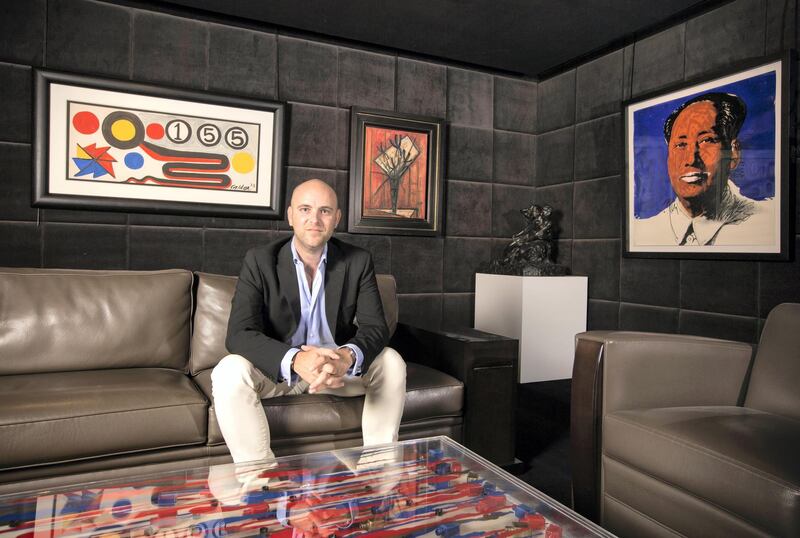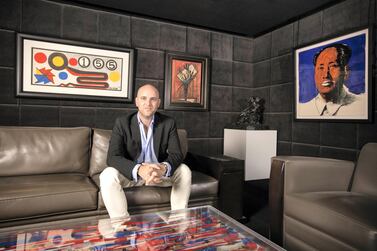There are many misconceptions about the art world. Among the top two are that it’s pretentious and that the art itself is unaffordable. But perhaps those perceptions are beginning to change, as industry professionals work to make collecting more accessible.
One of those people is Ghada Kunash, founder of Dubai gallery Fann A Porter, who recently launched an initiative and exhibition called AFA Collective, or Art For All Collective. Not only does this idea seek to support artists by developing a sustainable creative economy, but it also offers an interest fee installment plan that will ultimately give people of different backgrounds access to a market that has always appeared out-of-reach to many.
"Art is a tool for self-expression, an effective tool of communication between human beings, a universal language," Kunash tells The National. "In order for art to serve its purpose, it must be available and accessible for the public to interact with, allowing it to develop and grow.
“Our idea is simply to facilitate for collectors, and those who aspire to be collectors, of varied income levels to acquire and enjoy art.”
The success of an artist is often measured by how much he or she sells, she continues. “If we keep treating art as luxury items, trading and investing in it like real estate, hence limited to only those who can afford it, then we are surely limiting artists and collectors, and condemning creativity to become a commodity or a scarcity.”
Someone who agrees with her is Sylvain Gaillard, director of Opera Gallery Dubai, who says the internet and popular culture have helped to democratise the art world. "I am a true believer that art should be for everyone," he says. "I always say that art is the great equaliser, that a painting can speak to anybody, regardless of their knowledge of art, socio-economic background, race or religion. This is the beauty of art, it carries universal appeal that doesn't need to be explained or rationalised."
Yet, Gaillard does admit the “so-called art snobbery” still exists. “But it won’t be around for much longer,” he adds.
Gaillard made his first serious art acquisition in his early twenties, when he was a private banker covering Turkey. It was a painting by contemporary Turkish artist Kezban Arca Batibeki. Gaillard was inspired by a lawyer he knew who collected art. “I recall being fascinated by his collection and probing his mind as to how he started building it,” he remembers. “What came out of our discussion was a pivotal point for me, as I started following three strict rules: always meet the artist in person; visit the studio; and never go above a strict price limit that you should keep for an extended period of time.”
He did all three when buying his Batibeki piece, meeting the artist at her studio, talking with her at length and then falling in love with a piece that he says spoke to his soul. “Truth be told, I had to finance the artwork over six months, because it was slightly above my means at the time, but I didn’t care too much because it was an ‘I have to have it’ moment.” The piece now hangs proudly in his bedroom in Dubai and still brings Gaillard joy every time he looks at it. “Never underestimate the emotional satisfaction that you get from owning art, it’s by far the most rewarding aspect of collecting.”
While any number of people may also have that same ‘I have to have it’ epiphany when it comes to striking artworks, not many are willing to go into debt when buying it. Thankfully, over the past few years a burgeoning affordable art market has made it easier for enthusiasts to invest in pieces they love. “There is a cognitive dissonance between the value of art and its perceived quality,” says Gaillard. “There is tonnes of work by great artists that can be acquired for a very low amount, and there is no shame in collecting them. Historically, all of the best collections have been built by buying established and up-and-coming artists.”
This is where Kunash disagrees slightly. “Galleries have been trying to encourage buying art by curating ‘affordable art’ exhibitions, however affordable meant low in price but quality has been compromised as well.” That is why her new payment plans work, as it offers potential buyers a way to finance their purchase without compromising on artist excellence, but without bankrupting them in the process. The AFA Collective programme also serves to be educational to anyone and everyone, and through it Fann A Porter will also collaborate with other galleries, artists and similar institutions throughout the region and further afield. “At the moment, we’re working on programming a tour of one of our artists, Majd Kurdieh’s studios in Lebanon. The tour will be designed to understand the various development stages of an artist.” Kunash’s team will also soon expand the programme’s remit to encompass design, with an exhibition set to launch next month.
“Art is not bread and butter,” she says. “It is not something one cannot live without. In those days people are very careful about their spending, art can be on the bottom of the list for a person with an average income.” Her mission is not entirely altruistic, of course. As a gallery owner, Kunash has to reach targets and take care of her bottom line. Her aim is to ultimately reach collectors on every level of society and who have differing interests in art in the first place – whether culture vultures who wander galleries for the love of it, the wealthy elite looking to make an investment or the world’s decision-makers who see such acquisitions as a mark of power and status. “As a gallery, we endeavour to connect all these together to reach our target,” she explains.
But the goalposts are always changing, particularly since the advent of the digital era, says Gaillard. "A lot of very successful online platforms have emerged, with a unique focus on young collectors and affordable art, which is something I have a lot of respect for." In the UAE alone, these include Emergeast, Monda Gallery, Artiez Art Gallery, Kobo Art Gallery and The Art Cocoon, to name a few.
Perhaps the most important thing to remember about buying art, however, is that it’s not about the money. “Art is not real estate,” says Kunash. “It is not a piece of land or a villa, it is not a savings bank account that will safely add up to a certain percentage of interest yearly.” She adds there are two reasons someone buys art: because one likes the piece or because it is a “promising investment”. “In many, many cases number one only applies.” For number two, a collector should consult with a trusted art dealer and do their homework, she advises.
Gaillard reiterates this. “The art that you pick is an extension of yourself. It’s a vector for you to tell a story. I always advise people to buy what they love. This is paramount.” The most common mistake he sees is people trying to replicate other buyers’ choices. “Trust your gut feelings,” he says. “If you fall in love with a painting, chances are the artwork will bring you joy on a daily basis, which is the most important thing.”
This outlook on the art world is nothing new. “The Medici family in the Renaissance era in the 13th and 14th century were probably one of the best examples of art sponsors and collectors,” says Kunash. “Commissioning artists was practised by all great civilisations since the time of the pharaohs. They understood the importance of artists as much as they understood the importance of their scientists, poets and historians.
“It tells the story of a civilisation, as it documents and reflects the many aspects of its society as much as its literature and sciences.”







